Research Article Open Access
Microbial Degradation of Gasoline in Soil: Comparison by Soil Type
| Turner DA1, Pichtel J2, Rodenas Y3,2, McKillip J3 and Goodpaster JV1* | ||
| 1Department of Chemistry and Chemical Biology, Forensic and Investigative Sciences Program, Indiana University Purdue University Indianapolis (IUPUI), Indianapolis, USA | ||
| 2Department of Natural Resources and Environmental Management, Ball State University, Muncie, USA | ||
| 3Department of Biology, Ball State University, Muncie, USA | ||
| Corresponding Author : | Goodpaster JV Department of Chemistry and Chemical Biology Forensic and Investigative Sciences Program Indiana University Purdue University Indianapolis (IUPUI), Indianapolis, USA E-mail: jvgoodpa@iupui.edu |
|
| Received December 20, 2013; Accepted February 04, 2014; Published February 10, 2014 | ||
| Citation: Turner DA, Pichtel J, Rodenas Y, McKillip J, Goodpaster JV (2014) Microbial Degradation of Gasoline in Soil: Comparison by Soil Type. J Bioremed Biodeg 5:216. doi:10.4172/2155-6199.1000216 | ||
| Copyright: © 2014 Turner DA, et al. This is an open-a ccess article distributed under the terms of the Creative Commons Attribution License, which permits unrestricted use, distribution, and reproduction in any medium, provided the original author and source are credited. | ||
Related article at Pubmed Pubmed  Scholar Google Scholar Google |
||
Visit for more related articles at Journal of Bioremediation & Biodegradation
Abstract
During the investigation of a suspicious fire, debris is often collected from the scene and analyzed for residues of ignitable liquids (e.g., gasoline). In cases where the debris is contaminated with soil, it is known that heterotrophic soil microorganisms can alter the chemical composition of the ignitable liquid residue over time. The effects of soil type and season upon this phenomenon are not known, however. Hence, soil collected from locations under three different uses (residential, agricultural, brownfield) were spiked with gasoline and microbial degradation was monitored for 30 days. The soils were also chemically and biologically characterized. Gas chromatographic profiles showed that residential soil was most active and brownfield soil least active for the microbial degradation of gasoline. The brownfield soil possessed relatively high (497 mg/kg) concentrations of Pb, which may have affected bacterial activity. Predominant viable bacterial populations enumerated using real-time reverse transcriptase polymerase chain reaction (RT-PCR) included members of the Alcaligenes, Acinetobacter, Arthrobacter, Bacillus, Flavobacterium, and Pseudomonas genera. Principal Components Analysis (PCA) was found effective in elucidating trends of microbial degradation among the different soil types and seasons. The results of this study demonstrate the necessity of prompt analysis of forensic evidence for proper identification of possible ignitable liquids.
| Keywords |
| Soil chemistry; Bacteria; Microbial degradation; Ignitable liquids |
| Introduction |
| The number of incendiary fires in the U.S. averages approximately 210,300 every year, which comprises about 13% of the total of all reported fires, according to FEMA’s Topical Fire Report Series[1]. On an annual basis, incendiary fires claim 375 lives, injure over one thousand people, and cause approximately $1 billion in direct property damage [1]. In many cases, the arsonist uses an ignitable liquid to accelerate the fire. Gasoline is the most commonly used ignitable liquid as it is readily accessible, inexpensive and ignites easily [2]. Gasoline and other ignitable liquids are classified according to the American Society of Testing and Materials (ASTM) guidelines by their boiling point range and chemical composition [3]. In practice, a forensic chemist will use various extraction methods coupled with gas chromatography/mass spectrometry (GC/MS) to determine if an Ignitable Liquid Residue (ILR) is present in a fire debris sample. The ILR will then be classified according to ASTM guidelines [2,4]. |
| Media rich in organic matter such as soil provides a rich source of carbon and typically contains substantial quantities of active bacterial biomass. Since ignitable liquids are composed of a range of hydrocarbons, they may be suitable as a carbon substrate by bacteria. Such transformations are problematic for fire debris analysis as samples are often stored for many weeks at room temperature before they are analyzed due to case backlog and lack of cold storage. As a result, selective loss of hydrocarbon species due to bacterial metabolism can occur, making the identification and classification of ignitable liquid residues difficult or even impossible. For example, five specific C3- alkylbenzenes (3-ethyltoluene, 4-ethyltoluene, 1,3,5-trimethylbenzene, 2-ethyltoluene and 1,2,4-trimethylbenzene)must be identified in a sample in order to determine if residues of gasoline are present. Furthermore, because these compounds also occur in other materials, they must be present in relative amounts that are similar to that of a gasoline standard [3]. Among the serious consequences of microbial degradation are the selective losses of some of these compounds and/or changes in the ratios of these compounds in a gasoline sample. |
| Several factors affect bacterial numbers and activities in soil including soil type and season. Chemical and physical characteristics of soils including pH, nitrogen level and phosphorus content will vary, as do soil physical properties (e.g., texture). In turn, varying populations of bacteria may impact the degree of microbial degradation observed in fire debris samples containing soil. |
| Previous work has demonstrated that bacteria readily degrade normal alkanes (e.g. decane) and lesser substituted alkyl benzenes (e.g., toluene, ethyl benzene, propyl benzene) while more highly substituted alkyl benzenes (e.g., 1,2,4-trimethylbenzene) and highly branched alkanes are more resistant to microbial attack [4-6]. While treatment of hydrocarbon-contaminated soils by bacteria is a well-known phenomenon in the environmental engineering community [7-17], microbial processes are not wellunderstood in forensic science. This phenomenon likely varieswith soil type and over different seasons as soil chemical properties, temperature and moisture status may impact heterotrophic bacteria. |
| The overall objectives of this study were to assess the degradation of a common ignitable liquid (i.e., 87 octane gasoline) in soil as affected by soil type. The focus of this paper will be upon the effect of soil type, to include: (1) analysis of GC/MSdata from gasoline added to three different soils; (2) identification and quantification of bacterial populations present in the study soils; and (3) semi-quantification of organic and inorganic compounds present in the study soils by Principal Component Analysis (PCA). |
| Materials and Methods |
| Soil chemical analyses |
| Soil material was obtained from an agricultural field (Pella clay), a residential property (Miamian sandy clay), and a brown field site (Urban land/Wawaka-Miami complex clay) in central Indiana. Soil material was collected from the surface 0-20 cm of each site using a stainless steel sampling probe. The soil was composited in the field, and air-dried and sieved (< 2 mm mesh) in the laboratory. |
| Particle size distribution of the soils was determined using the hydrometer method [18]. Total organic carbon (TOC) and total nitrogen (N) were analyzed on a Perkin Elmer Series II CHNS/O Analyzer 2400 (Shelton, CT). Acetanilide was the standard used. Soil pH was determined using a 1:2 (w:v) solids: deionized water slurry with an AB15 Accumet pH meter. |
| Soil nitrate (NO3) concentrations were measured using Szechrome reagents [19] in a BioteK Power Wave XS2 micro assay system. Soil ammonium (NH4) concentrations were determined by the method of Sims et al. which uses a modified indophenol blue technique [20]. The method was adapted for the BioteK Power Wave system. Soil extractable P was determined by the Bray-1 method [21]. Soil K was extracted with neutral 1.0 M ammonium acetate and analyzed using atomic emission spectrophotometry (Perkin Elmer A Analyst 2000). Extractable metal (Cd, Cr, Fe, Zn, Pb) concentrations were determined by extraction with 5 mM DTPA (diethylene triamine penta acetic acid) with 10 mM CaCl2, pH adjusted to 7.3. Briefly, the method involved mechanical shaking (120 osc./min. for 2 h) of 5 g soil with 25 ml of 5 mM DTPA in acid-washed Nalgene® bottles. The suspension was filtered through Whatman No. 2 filter paper and analyzed for Cd, Cr, Fe, Zn and Pb using flame atomic absorption spectrophotometry (Perkin Elmer A Analyst 2000). For the above analyses, there were four replicates of each sample. |
| Soil Microbiological Analyses |
| Populations of total culturable bacteria were determined in each soil type using the standard plate count [22] on Plate Count Agar (Teknova, Hollister, CA).Soil borne actinomycetes were enumerated on Actinomycete Isolation Agar (Sigma-Aldrich, St. Louis, MO) and yeasts and molds were quantified using Sabouraud Dextrose agar (Fisher Scientific, Waltham, MA). Six replicates of each soil type colony counts were averaged following 48h incubation of all inoculated plates. Colony counts were assessed using exponential and log transformations via Sigma Stat 3.5 (Point Richmond, CA). Control and experimental groups were compared using a one-tailed Student’s t test, and different media combinations were compared using one-way ANOVA (Minitab 16, State College, PA), followed by Student-Neuman-Keuls post hoc analysis and two-factor factorial analysis using SAS (SAS Institute, Cary, NC). Data were considered significantly different at P< 0.05. |
| For the genetic identification of bacteria, DNA was obtained from 3-5 g soil samples using a commercial system (MoBIO, Solana Beach, CA) and quantified spectrophotometrically. Real-time PCR was carried out in a SmartCyclerII (Cepheid,Sunnyvale, CA). Extracted DNA (1 μg) was added to real-time SYBR Green™ Supermix (Quanta Biosciences, Gaithersburg, MD); a no-template contamination control was analyzed for each sample/primer set, as well as positive control specimens consisting of genomic DNA from ATCC (Manassas, VA) type strains or other reference strains of Acinetobacter, Alcaligenes, Arthrobacter, Bacillus, Burkholderia, and Flavobacterium (Table 3). All PCR primers were designed with the software analyses options available through the National Center for Biotechnology Information Basic Local Alignment Search Tool (NCBI BLAST) (www.ncbi.nlm.nih.gov/BLAST), which allows for sequences to be screened for nonspecific annealing frequencies and non-target homology determination. Internal standard primer targets in each case were the highly conserved prokaryotic gyrase subunit B gene, gyrB [23]. Each primer pair was tested on all non-target strains to ensure appropriate specificity and eliminate the appearance of false-positive amplification signal. Cycling conditions were 10 min. at 95°C, followed by 40 three-stepcycles of 15 s at 95°C , 1 min. at 55°C and 1 min at 72°C, with fluorescence acquisition monitored at the end of each cycle.In order to sensitively enumerate viable cell density, reverse transcriptase PCR was also subsequently performed on whole RNA extracted from 5 g soil of each treatment type using Trizol (Invitrogen, Grand Island, NY). RNA was standardized to 1 μg following DNAse-I treatment and subjected to cDNA synthesis and amplification using the qScript™ One-Step SYBR® Green qRT-PCR Kit (Quantas Biosciences) and genus-specific primers (Table 3). Viable cell densities were ascertained using the calculations described below for DNA targets and compared by soil type. |
| Standard curves to determine number of copies of target genomes (and mRNA)for each bacterial genus were constructed using quantified bacterial templates obtained from each reference strain 1:10 serially diluted in nuclease-free water to 10-6 (each diluted in triplicate) and subjected to amplification as described above. Bacterial template concentrations were converted to amplicon (PCR product) copies by multiplying the mean grams of DNA purified for each set of extraction replicates by 6.02 × 1023, and dividing that product by the product of the respective amplicon length in base pairs × 650 Daltons. Resulting plots depict the number of amplicon copies as a function of respective cycle threshold (Ct) values. |
| Microbial Degradation Studies |
| For each soil type, eightsample time points were prepared in triplicate by spiking 20 μL of commercial unleaded gasoline (87 octane) onto ~100 g soil in aclean, unused, but non-sterile quart-size paint can (i.e., real fire debris samples would not be collected in sterile paint cans). The samples were sealed and stored for 0, 2, 4, 7, 11, 15, 22, and 30 days. On each specified day, the samples were extracted using passive headspace adsorption-elution (a popular and widespread extraction technique for fire debris) [24]. In this method, one third (~7 × 9 mm2) of a charcoal strip (Albrayco Technologies, Cromwell, CT) was placed in each can and suspended in the headspace on a pre-baked (at 85°C) paper clip using nylon string. The re-sealed cans were heated at 85°C for 4 h. After cooling,the charcoal strips were removed and extracted with 400 μL of pentane with vortexing for ~1 min. Samples were then analyzed by GC-MS (Agilent 6890 GC with an Agilent 5975 MSD) using a standard method for fire debris analysis, which includes a 1 μL injection volume, 20:1 split ratio, inlet temperature of 250°C, flow rate of 1 mL/min (helium), a DB-5 30 m × 0.25 mm × 0.25 μm column, initial column temperature of 40°C held for 2 min, temperature ramp of 20°C/min, final temperature of 280°C held for 3 min, solvent delay of 2 min, MS scan of 40-300 m/z, MS quad temperature of 150°C and an MS source temperature of 230°C [4-6]. |
| Data Analysis |
| Each analyte (Table 2) was identified based on comparison to the retention time and mass spectrum of an authentic standard. A comparison was also made to the National Institute of Standards and Technology (NIST) mass spectral database. The peak areas from the summed extracted ion profiles (alkane: m/z 57, 71, 85, 99; aromatic: m/z 91, 120; benzaldehyde: m/z 77, 106) were exported into Microsoft Excel from the Xcalibur data analysis software (Thermo Scientific, Hanover Park, IL). Extracted ion profiles are employed in fire debris analysis in order to filter out interfering signals that could otherwise impede the classification of the ignitable liquid. The peak areas of the compounds listed in Table 1were normalized and then auto scaled. Normalization corrects for differences in overall instrument response and auto scaling allows the variance for each variable to be weighted equally [25]. XLSTAT (Addin Soft), an add-in for Microsoft Excel, was used to run Principal Component Analysis (PCA) on the autoscaled data for each soil type. PCA is a data reduction technique that allows for the visualization of samples in a two-dimensional plot despite the fact that the samples are described by many variables. For example, PCA has been used to discern differences in the relative chemical composition of samples that underwent evaporation versus microbial degradation [6]. |
| Results and Discussion |
| Soil chemical analyses |
| The results of the soil chemical analyses are summarized in Table 2. All soil samples contained high percentages of clay (29.8 to 53.9%). Soil textures ranged from sandy clay to clay. These textures are typical for much of the northern two-thirds of the state of Indiana, which is overlain by substantial deposits of till from the Wisconsin glacial epoch [26]. |
| Soil pH ranged from 6.3 (residential) to 6.6 (agricultural and brownfield). Total soil nitrogen (N) ranged from 0.23 mg/kg (residential and brownfield) to 0.44 mg/kg (agricultural) (Table 1). The brownfield soil had the lowest level of nitrate (NO3) at 26.3 mg/kg, whereas the agricultural soil had the highest level (60.9 mg/kg). Soil ammonium (NH4) levels were similar across soil type, ranging from 1.9 mg/kg (brownfield) to 3.0 mg/kg (residential). Soil TOC was similar across treatments with values ranging from 0.9 to 1.0 %. The residential soil contained high levels of phosphorous (P) and potassium (K) due to treatment with commercial fertilizers. |
| Levels of extractable Cd, Cr, Fe and Zn were all within range for non-contaminated soils (Table 1). However, extractable Pb levels in the brownfield soil measured 497 mg/kg. An upper limit for Pb content of a normal soil is approximately 70 mg/kg [27]. The levels of Pb in soils that are toxic to soil microorganisms and plants are a function of species, Pb concentration and soil factors (e.g., pH, fertility status, presence of other toxins); thus, threshold toxicity levels will vary. Soil Pb levels considered toxic to biota have ranged from 100 to several thousand mg/ kg [28,29]. In addition to the high Pb concentration, the brown field soil had a “massive” structure (i.e., it was highly compacted and did not allow water to infiltrate or to percolate). Such a structure is detrimental to plant growth and may inhibit microbial growth and activity, due to lack of both moisture and O2. The other two soils had a granular structure, which is much more conducive to water (and air) movement. |
| Soil microbiological analyses |
| Populations of recoverable aerobic chemoheterotrophic bacteria were analyzed from each soil treatment using Standard Plate Count on Plate Count Agar. Table 2 reveals the average density was not significantly different (p>0.05) across soil types at 3.8 × 105 cfu/g. Likewise, detectable actinomycetes remained stable as well (average = 6.9 × 105 cfu/g, and were not significantly different for any soil treatment (p>0.05). Total recoverable fungal counts similarly revealed no significant differences among treated soils(1.1 × 105 cfu/g). However, since culture-based methods reveal only a subset of a microbial population in any given sample, PCR was used to determine comparative levels of selected bacterial genera across soil types in order to deduce what roles if any each genus may play in degradation of the ignitable liquid used here. |
| rDNA-based PCR detection was used to quantify total genome equivalents for representative bacterial genera demonstrating a previous history in the literature of chemical adulterant metabolism in soil environments [30-34]. Specifically, Acinetobacter, Alcaligenes, Arthrobacter, Bacillus, Flavobacterium, and Pseudomonas genera were analyzed here by qPCR using genus-specific PCR primers and standard curves generated with ATCC type strain DNA (Table 3). The calculated total genome equivalent of each bacterial genus is shown in Table 3. These qPCR results reveal that in all soil treatments, Alcaligenes spp. was consistently detectable at significantly higher levels (p< 0.05) than any other genus. A. faecalis has been reported to degrade the chlorinated insecticide endosulfan, found routinely in many soil types, water, and as residue on foods due to its widespread use in, and rapid transport through, the natural environment [35]. Other species of this genus have been documented to degrade PCB [36,37], whereas A. faecalis, the same species detected in our study, has been reported to metabolize the organo-chlorine insecticide endosulfan [38]. However, studies such as the ones cited are frequently performed in sterile soil spiked with known strains of interest rather than assessing naturally-occurring strains as was done herein. Nevertheless, such work reinforces the notion that the success of any bioremediation approach is directly related to the quality and diversity of competing species inhabiting the soil community, among other factors. Our selection of these six genera was based on dominant populations seen in soils of this region from past work in our laboratory. The possibility exists that levels of this and perhaps other species of Alcaligenes are present in the soils analyzed in our study due to some effect by a ubiquitous chlorinated derivative or similar chemical adulterant. Calculated genome copies of each bacterial group using rDNA-specific PCR revealed densities many orders of magnitude above recovered bacterial densities on plate count agar. This is attributed to the fact that our DNA-based PCR is detecting template copies from both viable bacterial targets and from dead cells accumulated in the soil biomass. However, these numbers are nevertheless still quite revealing on relative levels of each genus across soil types, and will be even more interesting in further examination of these soils when compared seasonally. |
| It is well known that DNA-based PCR detects both dead and viable bacteria, however, so in order to more accurately ascertain levels of only viable bacterial generaplaying an active role in biodegradation, we targeted mRNA and quantified only bacteria actively transcribing their respective rDNA genes (Table 3) [39]. Alcaligenes appears at the highest viable density in residential soil, and the lowest in Brownfield soil. Moreover, in the DNA-based PCR detection assays, Alcaligenes spp. was among the most prevalent genera, suggesting that these bacteria do represent a substantial member of the microbial community in all soil types analyzed here. However, even in the more industrially contaminated soil type, 80,000 copies/g of Alcaligenes were detected suggesting these bacteria persist using an as-yet-undetermined physiological mechanism in the presence of lower NO3 and higher Pb levels, and/or in the presence of chlorinated adulterants as noted above, an area of future research interest. |
| Based on DNA PCR results (Table 1), residential soil exhibited the largest variation in levels of bacterial genera under study compared to other soil types, as well as the highest levels of bacteria overall. However, qRT-PCR results (Table 4) speak to a slightly different proportion of viable bacteria. Pseudomonas spp. were detected at the lowest levels in residential soil (3.00×105/g) while the spore-forming Bacillusspp and Alcaligenes were at the highest viable density (3.06×1017 and 5.56×1013, respectively). |
| Microbial degradation studies |
| Microbial degradation of gasoline was observed in the residential, agricultural, and brownfield soils(Figure1 and 2). In all three soil types, n-alkanes were degraded in a similar fashion in that degradation is almost complete after 7 d. In fact, no peaks remained in the chromatograms by 15 d except those attributed to volatile aldehydes that are present in the headspace of all soil samples (Figure 1). In contrast, we noted differences in the ratios of the C3-alkylbenzenes depending upon soil type (Figure 2). For example, all profiles appear nearly identical on day 0, but on day 2 propylbenzene (peak 1) is significantly reduced in |
| comparison to 3-ethyltoluene (peak 2) in the residential soil whereas in the agricultural and brownfield soils only minimal reduction is apparent. By 30 d the gasoline in residential and agricultural soils experienced the greatest microbial degradation while the gasoline in the brownfield soil experienced the least.It is important to note that in all chromatograms, the data is normalized to the most abundant peak in the chromatogram so that overall changes can be observed relative to the day 0 samples due to the lack of an appropriate internal standard. Therefore it may appear that some peaks are increasing in abundance, due to the changes in ratios of these compounds over time. Also, a minor peak appears between peaks 4 and 5 in the chromatograms after 15 and 30 days on agricultural soil that does not appear to be present in residential or industrial soil. This peak has been tentatively identified as a bicyclic hydrocarbon based on the mass spectral library. Gasoline contains a variety of hydrocarbons and could very likely contain this compound in trace amounts which would not be detected in a fresh or even slightly degraded sample. Additionally, the variability of degradation might explain why this minor peak is not detected in the significantly degraded residential and industrial soil samples. |
| These trends may be the result of the higher levels of nutrients in the residential and agricultural soils - both soils contained higher NO3, NH4 and K concentrations compared with the brownfield soil (Table 1). Furthermore, the residential soil contained more than twice the extractable P compared with the brownfield soil (154 versus 74 mg/ kg, respectively).Another factor may be the Pb concentration in the brownfield soil (497 mg/kg), which may have impairedthe activity of heterotrophic bacteria. A number of researchers have determined a direct relationship between concentrations of soil Pb and microbial activity in soil [40-42]. Shi et al. found that soil Pb decreased microbial activities and led to accumulation of soil organic carbon [43]. Furthermore, Pb was found to pose a greater stress to soil microbes than did other heavy metals. Application of Pb at concentrations of >500 mg kg−1 caused an immediate and significant decline in microbial biomass [41]. |
| Zeng et al. [40] state that soil Pb concentrations >500 mg Pb/kg may be a “critical concentration”, causing a significant decline in soil microbial activity. Therefore, nutrient content is most likely responsible for significant degradation in the residential and agricultural soil sampling, while high lead content is likely responsible for the reduction in microbial degradation of gasoline in the brownfield soil sampling. |
| Principal Components Analysis (PCA) was then used to calculate a set of latent variables that would better explain the overall variance in the data set. Figures 3-5 shows the factor loadings and the factor scores (known as a “bi-plot”) from PCA of the fall sampling from each soil type. This biplot shows both the projections of the data in the new factor space and the projections of the original variables. By examining the relative locations of the observations and variables over time, we can determine what variables are more important for a given data point. |
| For example, in the residential soil at day 0, the major contributors to the relative composition of the gasoline samples are the normal alkanes and the mono-substituted alkyl benzenes (Figure 3). As degradation proceeds, however, the major contributors to the relative composition of the gasoline samples are the xylenes, ethyltoluenes, and trimethyl benzenes. By days 22 and 30, all of these compounds are completely degraded and the only compound strongly associated with the gasoline samples is benzaldehyde, which is a suspected degradation product of toluene [44]. |
| The overall degradation rate appears to be slower in the agricultural soil (Figure 4) as the n-alkanes and the mono-substituted alkyl benzenes are still major contributors in the day 2 samples. Recall that in the residential soil the major contributors in the day 2 samples were the xylenes, ethyltoluenes, and trimethyl benzenes. However, in the end the agricultural soil samples are still significantly degraded by 22 days when the gasoline samples are only associated with benzaldehyde. |
| The brownfield soil (Figure 5) follows a similar trend to the agricultural soil except the day 22 and 30 samples are largely associated with toluene as well as benzaldehyde. Thisindicates that the brownfield soil was less active than the other soil samples, as toluene is the most abundant compound in gasoline and is one of the first compounds to be significantly decomposed by soil bacteria. |
| Conclusion |
| Our results demonstrate the necessity for prompt analysis of forensic evidence from fire scenes in order to properly identify ignitable liquids. In this study, microbial degradation was apparent in all soil samples. However, ignitable liquid residues in the brownfield soil suffered the least while ILR in the residential soil suffered the most. It was expected that the residential soil would suffer the most degradation as the bacteria counts were highest in this soil type. It was not anticipated that the brownfield soil would show the least microbial degradation, although, the increased levels of heavy metals in this soil (lead in particular) likely had a toxic effect on the soil bacteria, as suggested by the RNA-based quantification experiments. Alcaligenes and Pseudomonas spp., widely recognized as universal soil borne microbes capable of degrading many chemical adulterants, were not major metabolic participants in this study, although future work that specifically detects activity of genes encoding known factors for biodegradation would reveal the potential for these genera in these soils. |
| Acknowledgements |
| The authors would like to thank Mark Ahonen and Kathy Boone of the Microanalysis Unit of the Indiana State Police Laboratory for the idea behind this project and for their continued feedback on this work. Financial support for this work originated from the Research Support Funds Grant at IUPUI and the National Institute of Justice, Office of Justice Programs, U.S. Department of Justice (Award No. 2010-DN-BX-K036). The opinions, findings, and conclusions or recommendations expressed in this publication are those of the authors and do not necessarily reflect those of the U.S. Department of Justice. |
References
|
Tables and Figures at a glance
| Table 1 | Table 2 | Table 3 | Table 4 |
Figures at a glance
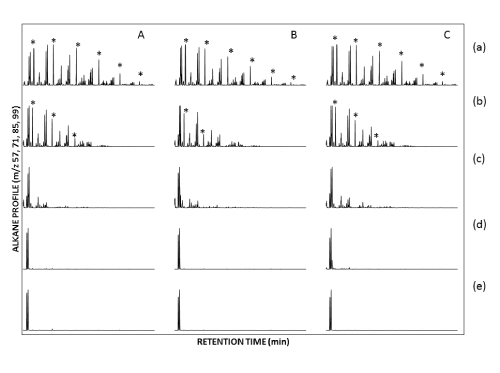 |
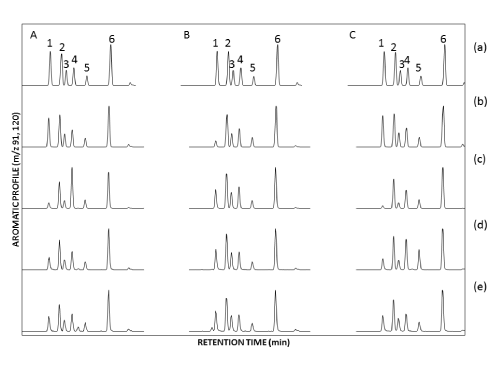 |
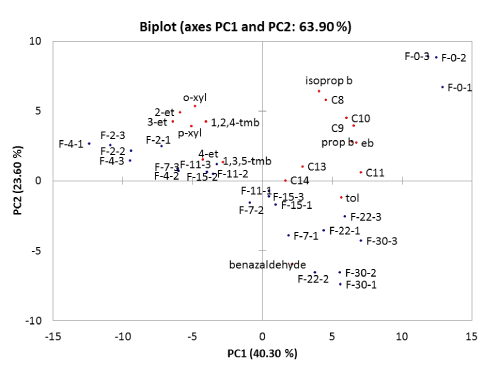 |
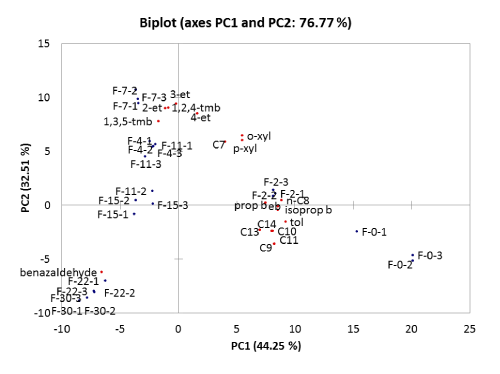 |
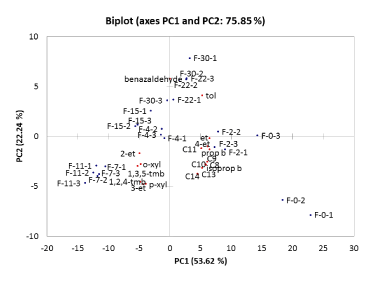 |
| Figure 1 | Figure 2 | Figure 3 | Figure 4 | Figure 5 |
Relevant Topics
- Anaerobic Biodegradation
- Biodegradable Balloons
- Biodegradable Confetti
- Biodegradable Diapers
- Biodegradable Plastics
- Biodegradable Sunscreen
- Biodegradation
- Bioremediation Bacteria
- Bioremediation Oil Spills
- Bioremediation Plants
- Bioremediation Products
- Ex Situ Bioremediation
- Heavy Metal Bioremediation
- In Situ Bioremediation
- Mycoremediation
- Non Biodegradable
- Phytoremediation
- Sewage Water Treatment
- Soil Bioremediation
- Types of Upwelling
- Waste Degredation
- Xenobiotics
Recommended Journals
Article Tools
Article Usage
- Total views: 16503
- [From(publication date):
February-2014 - Sep 21, 2024] - Breakdown by view type
- HTML page views : 11965
- PDF downloads : 4538
